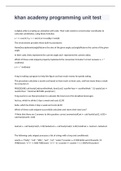Exam (elaborations)
khan academy programming unit test exam 2022/2023
- Course
- Institution
A digital artist is creating an animation with code. Their code needs to convert polar coordinates to cartesian coordinates, using these formulas: x = r × cos( θ )y = r × sin( θ )x=r×cos(θ)y=r×sin(θ) The environment provides these built-in procedures: NameDescriptionsin(angle)Returns the...
[Show more]



